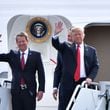Sometimes you’re the windshield, sometimes you’re the bug. Nearly 100 days in, we’re still watching Donald Trump and Washington to see which is which.
A burst of legislative activity this week seeks to quiet the narrative the Trump’s presidency has accomplished too little as it approaches that traditional milestone. No Obamacare replacement yet? Here’s a conservative-friendly tweak to the bill — but no timetable for a vote. No major jobs legislation yet? Here’s an outline of the tax reform we’ll tackle — after “listening sessions” next month.
But to a large extent, the fact we’re having this kind of conversation suggests Washington is winning so far.
Remember, the "Trump Train" was supposed to roll right through the capital, disrupting D.C.'s M.O. Americans didn't vote for Trump because of his policy details, because for the most part those did not exist. They voted for him for his attitude, his non-adherence to politics as usual. He fights!
When it comes to rhetoric, Americans have indeed watched a presidency that in its first three months may well have been unlike any other. In terms of actions, however, what’s most surprising is how conventional Trump has been.
Trump’s primary policy-making tool so far has been the executive order. That’s hardly a departure from his predecessor, except that Trump so far is even more prone than Barack Obama to picking up the pen instead of the phone. One of those orders may have been to review regulations with an eye toward reducing them, but the basic problem — lawmaking via the unelected bureaucracy rather than the elected Congress — remains.
Speaking of Congress: Like Obama (in late 2009) and George W. Bush (circa 2005) before him, Trump is finding legislative majorities don’t necessarily clear the path for his legislative priorities. For all the time and energy we devote to the election of one person, and despite the ever-growing reliance on executive action, the biggest and most enduring changes in this country still require 1) a majority of 435 persons, and 2) a super-majority of 100 others. And they often have their own ideas about how to go about things.
On foreign policy, it’s too soon to say how closely Trump will follow convention. At the first sign of trouble in the Middle East, however, he did what a number of previous presidents have done (Bill Clinton, toward bin Laden in Sudan) or wanted to do (Obama, when Syria’s Assad crossed his “red line”): He lobbed some missiles at it. That’s not “boots on the ground,” but nor was it a clear sign of not “being the policeman of the world” and “let(ting) Syria and ISIS fight,” as candidate Trump said the U.S. must do. In other words, it was within the mainstream of past White House policy.
One might find specific actions that fall outside the usual bounds, but not many, and not very far. (Remember, we’re sticking here to actions, not merely words.) To date, Trump hasn’t altered the way Washington works so much as felt out ways to work within the parameters that existed when he arrived.
You might find that comforting. You might find it disappointing. But you won’t find a Washington drastically remade in Trump’s image. So far, he only talks as if he’s larger than life.
About the Author





